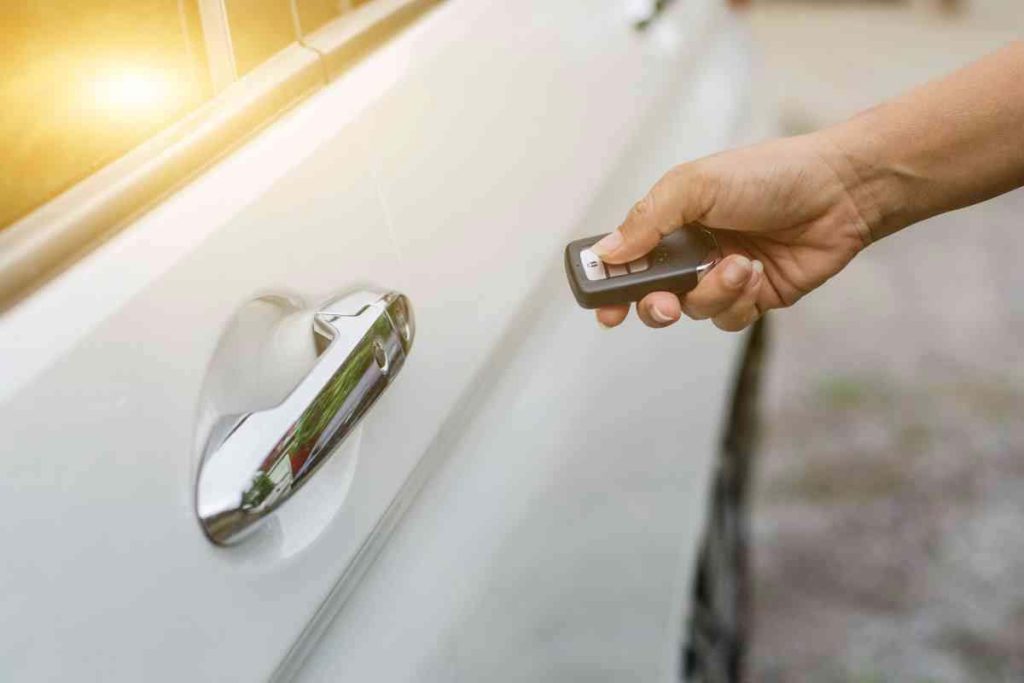The keyless entry and starting system, also known as the “keyless” or “keyless entry and start” or “smart key”, works through a combination of wireless technologies and sensors that allow you to open the car doors and then, once on board, start it without inserting the classic physical key on the steering lock, but simply by pressing the “START” button.
Keyless
Keyless is a nice convenience, especially if we have our hands full. Thanks to the keyless system it is possible to open both the doors and the trunk. Furthermore, when we stop we can turn off the engine using the button and go out with the key in our pocket while the doors close with a simple touch on the external handle. Identification occurs by detecting the low frequency radio signal emitted by the key through dedicated antennas located on the car. Radio waves are emitted as soon as we are in the vicinity of the car and the antennas are often integrated into the door handles.
Operation of the “keyless” system:
- Key detection: the keyless key contains a transmitter that sends a coded radio signal. When we approach the car, the sensors integrated into the car detect the presence of the key within a radius of usually a few meters.
- Unlocking the doors: Once the key is detected nearby, the system unlocks the doors automatically without the need to press a button on the remote control or the key itself. This is done via a radio signal that communicates between the key and the receiver inside the car.
- Starting the engine: To start the engine, simply press the button inside the car. The system again detects the presence of the key inside the car and, if the key is recognized as authorized, allows the engine to be started.
- Safety: keyless entry and start systems are designed to ensure the safety of the car. For example, the key transmits a unique, hard-coded security code that must be correctly identified by the car's receiver before the doors can be unlocked or the engine started. This makes it more difficult for thieves to replicate or intercept the key's signal.
- Automatic shutdown: Some keyless entry and start systems can also automatically turn off the engine when the key is removed from the car for a certain period of time, adding an extra layer of safety in case the driver forgets to turn off the engine.
Frequencies used
The frequencies used for keyless keys vary depending on the manufacturer and car model. The most common frequency bands are:
- 315MHz: Mainly used by American and Asian-made cars.
- 433MHz: used mainly by European-produced cars.
- 868MHz: used by some high-end car models.
In addition to these frequencies, some keyless systems also use the technology Bluetooth low frequency (BLE) for communication between the key and the car.
All modern keyless systems use encryption to protect the signal from interceptions and intrusions.
Here are some frequencies used:
- FCA/Stellantis: 315 MHz and 433 MHz
- Ford: 315 MHz and 433 MHz
- General Motors (GM): 315 MHz and 433 MHz
- Volkswagen Group: 315 MHz, 433 MHz and 868 MHz
- Hyundai-Kia: 315 MHz and 433 MHz
- BMW: 315 MHz, 433 MHz and 868 MHz
- Mercedes-Benz: 315 MHz, 433 MHz and 868 MHz

In general the systemkeyless” provides greater comfort to the driver by eliminating the need to manually insert the key into the ignition and to unlock the doors. However, it is important to be aware that there are potential vulnerabilities related to security due to tools (Grabbers, scanners, etc.) that “digital” thieves are equipped with through which they manage to intercept signals and clone the opening system of the remote control.
How to defend yourself from scanners, jammers and grabbers
Keyless technology uses an encrypted radio signal that is exchanged between the key and the car. This system can be vulnerable to some types of attacks aimed at stealing the car itself. How to protect yourself? Here are some recommended precautions:
- Keep the key safe: Be sure to keep your keyless key in a safe place when not in use, preferably in a bag or key ring protected by RFID (Radio Frequency Identification) that prevents unauthorized reading. Do not leave it in the pocket emptier which is usually located near the front door.
- Deactivate the key when not in use: Some keyless keys have the ability to be manually deactivated (see video). Be sure to deactivate your key when not in use, especially if you are in public places or near potential thieves. Find out how to deactivate your car key from the instruction booklet.
- Install additional safety devices: It may be helpful to install additional security devices such as anti-theft devices or GPS tracking devices to help locate your car in the event of theft.
- Update the car software: Keeping your car software up to date can help protect against any security vulnerabilities that can be exploited by bad actors. Check with your car manufacturer to see if there are security updates available for your keyless system and follow their recommendations.
- Use additional mechanical devices: There are mechanical devices to lock pedals or the steering wheel which can be a deterrent to thieves, thus reducing the risk of theft.
Taking these precautions can help reduce the risk of theft or unauthorized access to your car with keyless technology. However, it is important to be aware that no security system is completely invulnerable, so it is always good to be vigilant and careful.
#Keyless #works #benefits #risks
